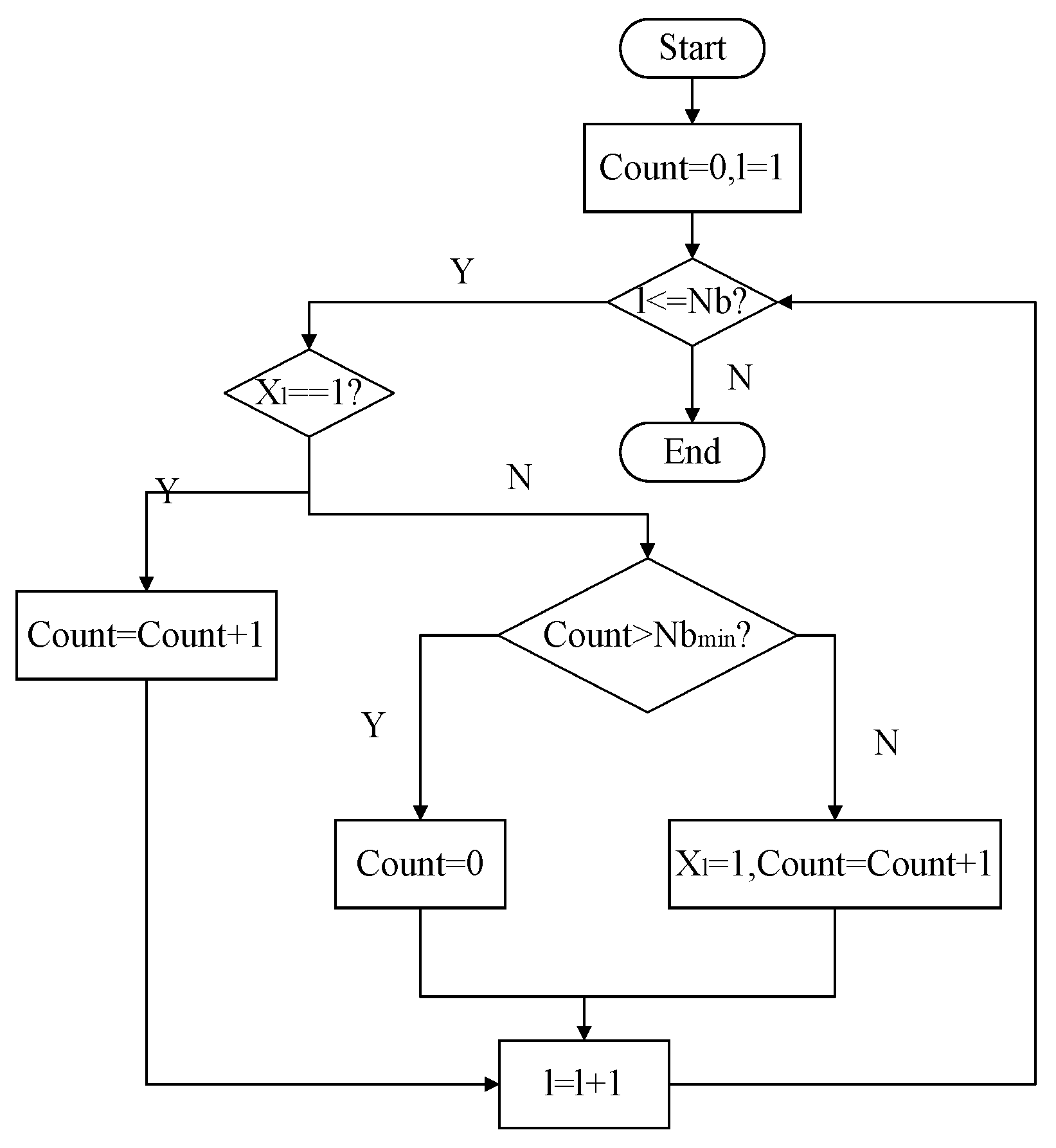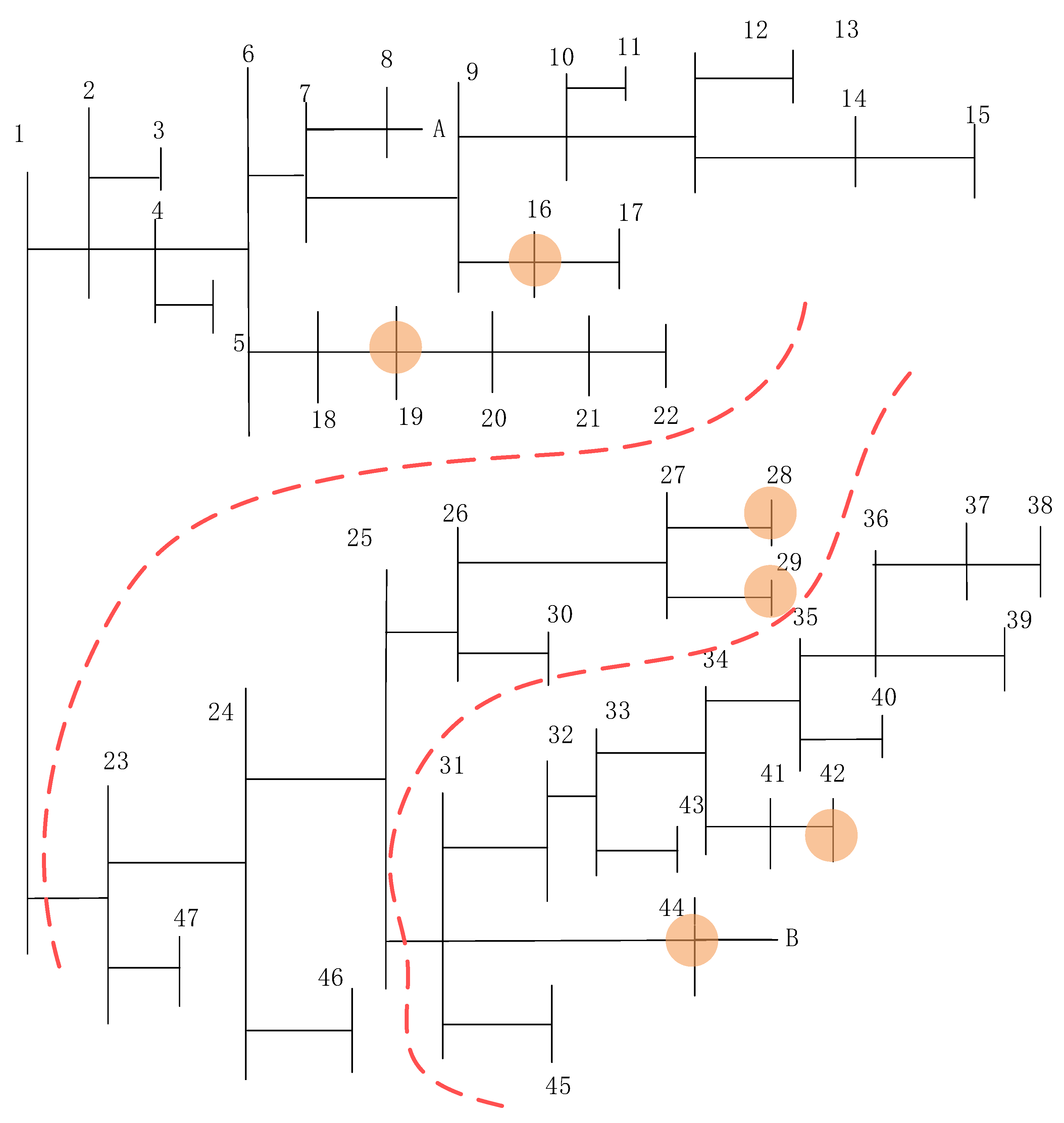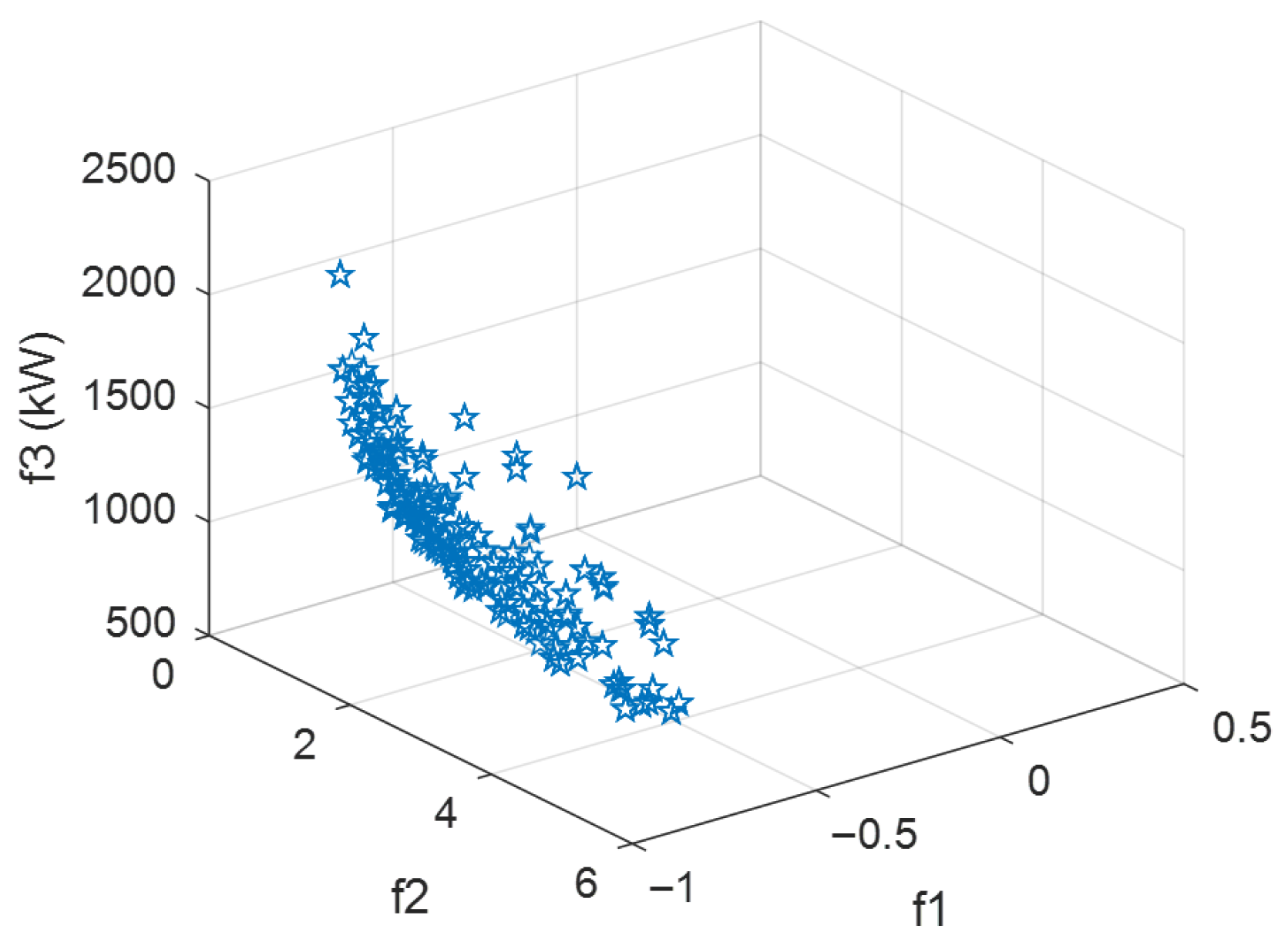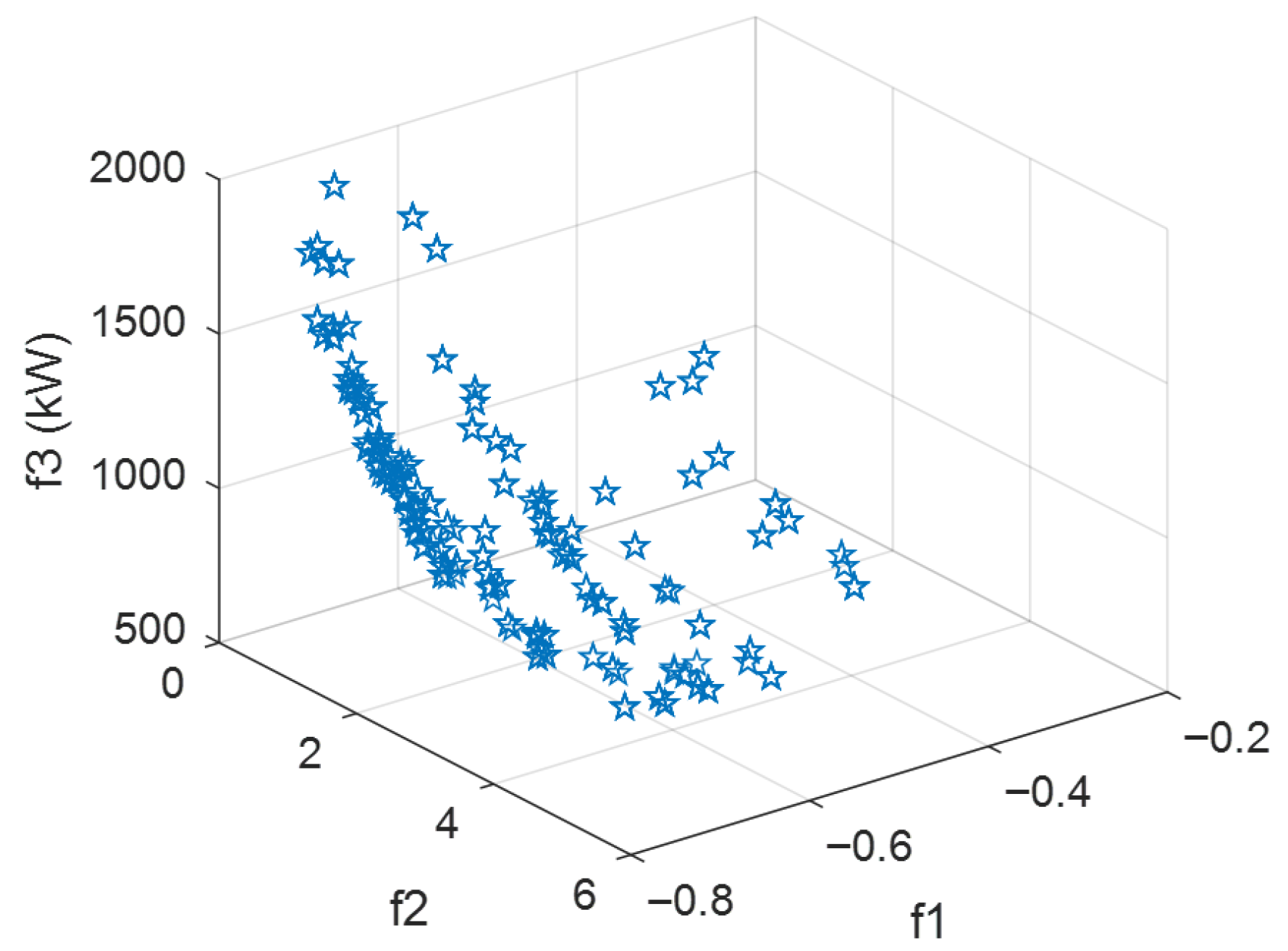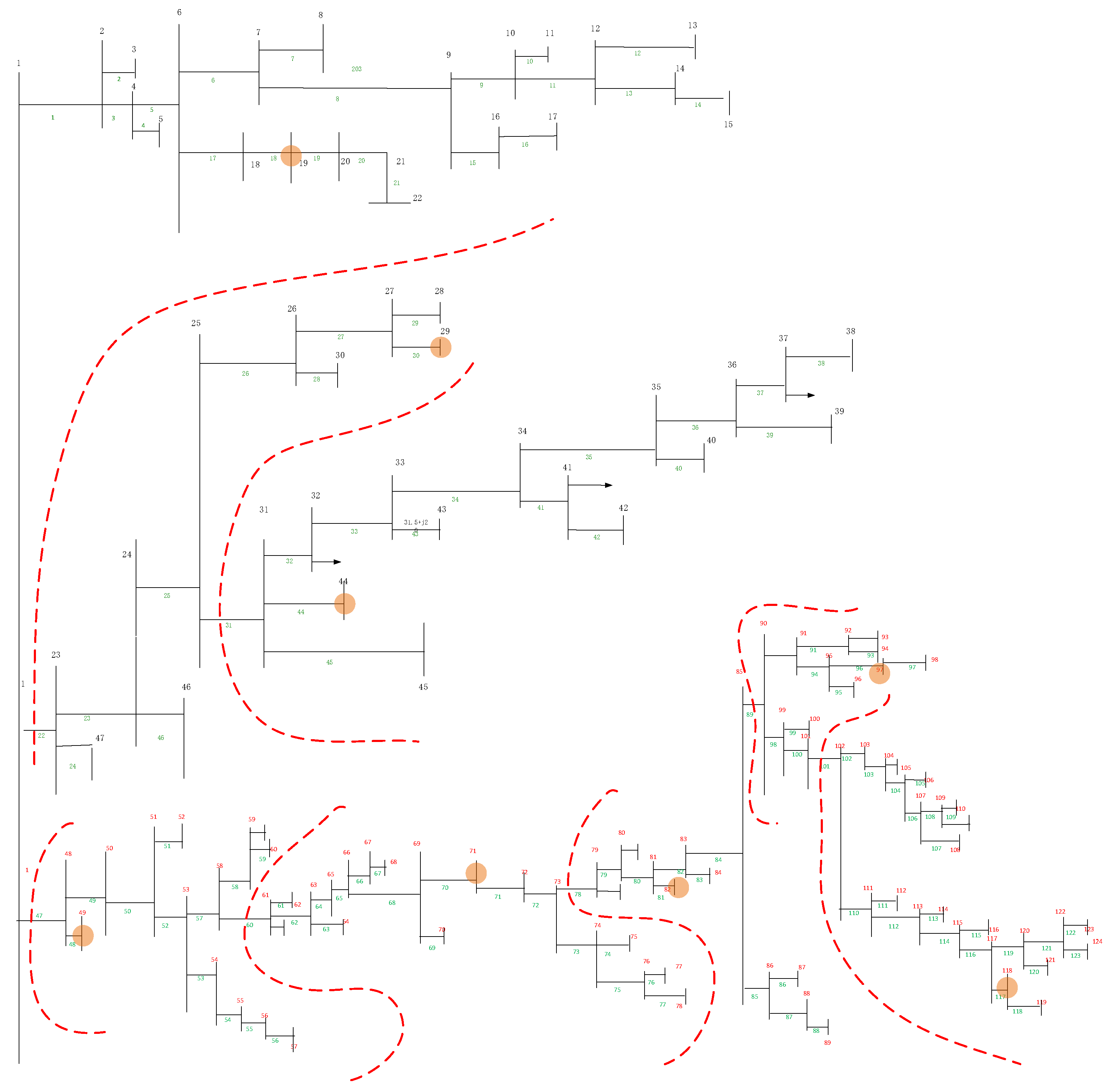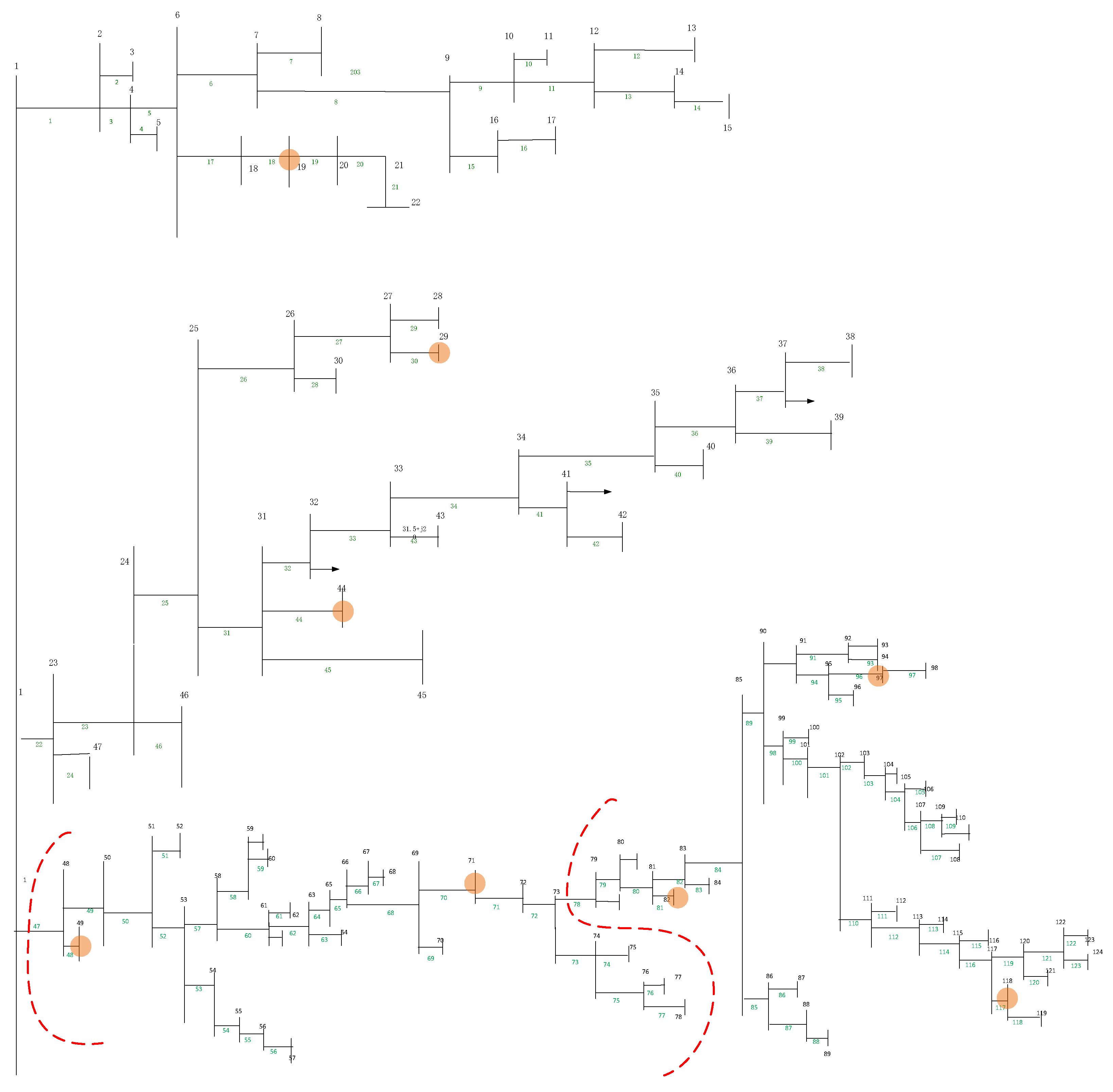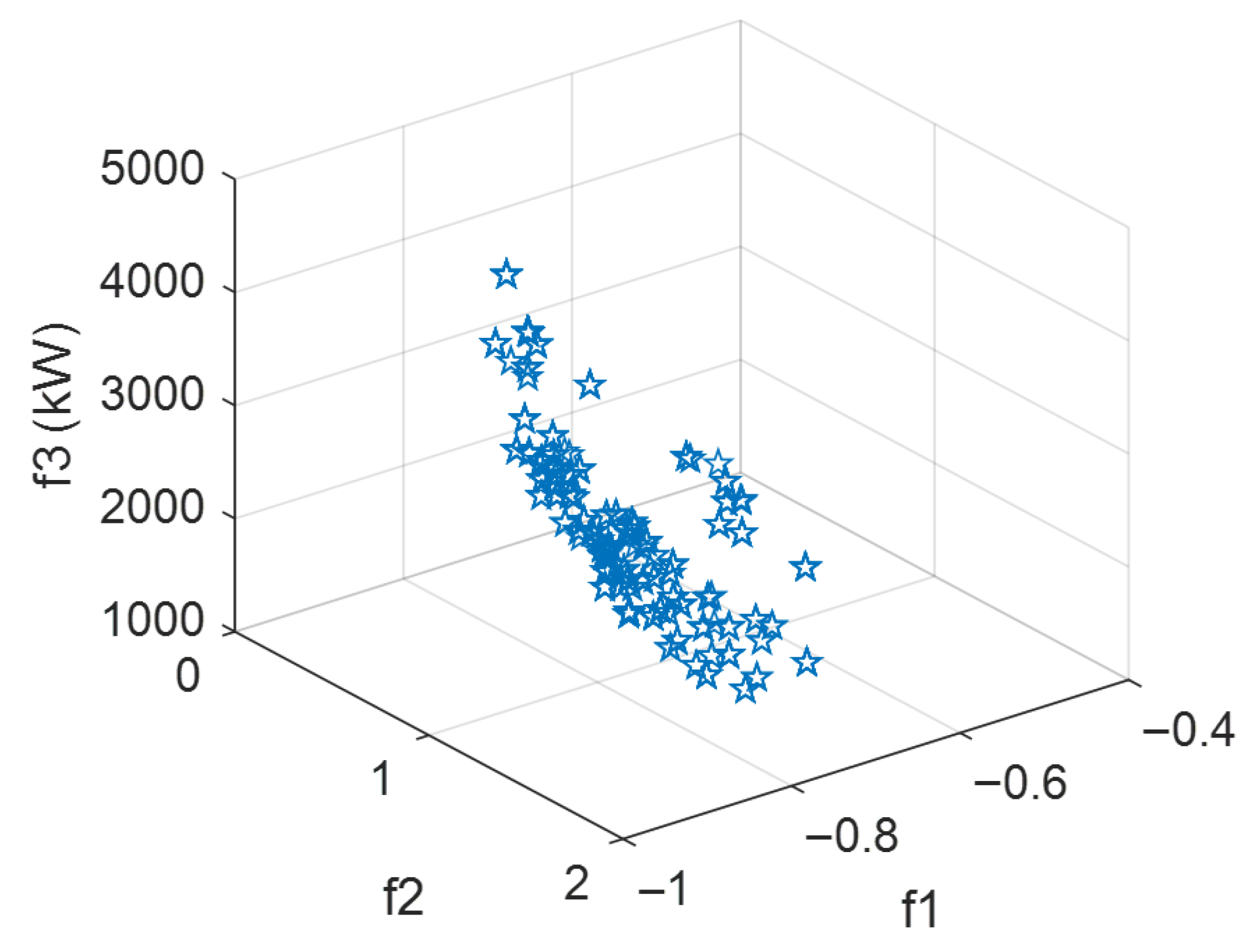1. Introduction
The intensification of the global energy crisis and environmental pollution has led to heightened focus on developing and utilizing renewable clean energy sources. Currently, renewable sources like wind and solar power are predominantly integrated into distribution networks as distributed energy resources (DERs). While partially dispatchable and providing limited frequency support, these DERs are transforming distribution networks from passive infrastructures into active distribution networks (ADNs) [
1]. However, the inherent randomness, intermittency, and volatility of DERs pose significant challenges to ADN optimal operation [
2]. First, the partial dispatchability of certain renewable energy units and even some loads extends the traditional reactive power optimization problem to an integrated active–reactive power optimization challenge [
3,
4]. Second, large-scale DER integration complicates network topology and power flow directions, rendering traditional optimization methods designed for single-feed radial networks inadequate for modern ADNs [
5,
6].
Furthermore, as the penetration level of distributed generation continues to increase, the number of decision variables in active distribution network optimization grows dramatically, while system operational constraints have become more complex. On the one hand, traditional serial solution algorithms—whether mathematical programming methods or heuristic algorithms—encounter limitations such as memory overflow, slow convergence, and dimensionality issues, rendering them increasingly unsuitable for expanding active distribution networks. On the other hand, with the integration of distributed energy resources and energy storage devices, the physical characteristics of distribution networks have changed from purely passive to active, with significantly enhanced dispatchability. They are gradually showing multi-agent characteristics. Moreover, in the context of an open electricity market, different investment entities pursue different operational goals, and there are even interest competition relationships among them, making the issue of subject information protection increasingly prominent [
7]. Currently, centralized optimization scheduling methods are predominantly employed in distribution networks [
8]. This approach requires acquiring comprehensive system-wide information to compute optimal scheduling strategies at a central control center. As system scales expand and models grow increasingly complex, centralized methods increasingly fail to meet requirements for both solution accuracy and computational efficiency. Moreover, they cannot adequately safeguard the privacy of diverse stakeholders in deregulated electricity market environments.
To address the aforementioned issues, China currently adopts a hierarchical and partitioned management approach for large-scale power systems [
9]. Under the current hierarchical and partitioned management framework of power grids, a reasonable partitioning method is a prerequisite for secure grid operation. Determining how to partition the grid appropriately is a key research topic in hierarchical and zonal management [
10]. Currently, there are two main approaches to power grid partitioning: one is based on administrative regions or geographical locations, and the other is the reactive power–voltage control partitioning method.
Partitioning based on administrative regions or geographical locations offers simplicity and practical implementation [
11]. Decision-makers typically draw on experience to ensure adequate reactive power sources within each partition, thereby upholding the “localized balancing” principle to a certain extent. However, methods based solely on geographical or administrative boundaries neglect electrical interconnections between network segments. As active distribution networks grow in scale and complexity, relying exclusively on operator experience becomes insufficient for comprehensive analysis of network characteristics and operational conditions. Consequently, the practical applicability of this approach is increasingly limited.
Reactive power–voltage control partitioning represents an effective method for enhancing voltage stability and ensuring secure system operation. Current research in this domain primarily focuses on approaches that utilize electrical distance constructed from voltage/reactive power sensitivity to characterize nodal coupling strength, which then guides the application of appropriate partitioning techniques for network segmentation [
12,
13,
14,
15]. These partitioning methodologies can be categorized into three types: (1) Graph-theory-based approaches [
16,
17,
18]: Reference [
19] employs electrical distance eigenvalues to determine partition numbers, subsequently applying a Ward distance-based agglomerative hierarchical clustering algorithm to cluster the electrical distance matrix, obtaining optimal reactive power partitioning results. Reference [
20] introduces modified electrical distance to identify critical-load nodes using spectral clustering algorithms for distribution network partitioning. Reference [
21] proposes an integer programming-based dynamic graph partitioning method for power systems that explicitly incorporates operational constraints into the partitioning algorithm, thereby ensuring partition reliability. (2) Heuristic approaches: Some researchers formulate mathematical models to transform the partitioning problem into an optimization framework, subsequently solved via heuristic algorithms. Reference [
22] employs a multi-objective genetic algorithm to solve the optimization model, obtaining partitioning schemes with tightly coupled internal zones and loosely coupled inter-zone connections. Reference [
23] simultaneously accounts for intra-zone electrical coupling tightness and reactive power margins to construct an optimized partitioning model, solved using a multi-objective adaptive evolutionary programming algorithm. (3) Community detection methods [
24,
25,
26]: Reference [
27] employs electrical coupling strength to automatically identify boundary nodes of virtual microgrids using an improved Newman’s fast partitioning algorithm. This partition distribution networks into multiple virtual microgrids with high internal convergence characteristics, achieving effective network segmentation. Ref. [
28] incorporates photovoltaic generation impacts on nodal voltages during partitioning and solves the model based on modularity functions, yielding more rational partitioning schemes for distribution networks with high PV integration.
As discussed above, existing domestic and international research has provided diverse methodologies for grid optimization partitioning, yet these approaches remain limited in scope regarding partitioning criteria. The first method inherently divides distribution networks into sub-regions, neglecting internal nodal electrical interconnections [
29]. The second method performs reactive power–voltage control partitioning based on the electrical coupling strength between nodes, adhering to the principle of “strong intra-zone coupling and weak inter-zone coupling” [
30,
31]. While this methodology prioritizes system voltage stability and operational security during partitioning, it fails to consider the impact of zonal configuration on computational efficiency in dispatch optimization. Notably, research on distribution network partitioning from the perspective of enhancing parallel computation efficiency remains scarce in the current literature.
Parallel computing [
32] can significantly improve the computational efficiency of zonal coordination optimization, making it particularly suitable for optimization calculations of modern active distribution networks with larger scales and more complex network structures. Neglecting parallel efficiency during zoning may lead to excessively long waiting times between processes in parallel computation, increasing the complexity of the optimization model and the difficulty of solving it. Rational zoning of the distribution network can reduce the waiting time between different regions during parallel computation of the system and improve the utilization efficiency of computing resources. Therefore, the results of zoning have a significant impact on the optimization efficiency of the distribution network. However, existing research exhibits the following limitations:
- (1)
While partitioning schemes are important factors affecting parallel efficiency, most current power grid partitioning methods carry out reactive power and voltage optimization partitioning from the perspective of stabilizing the system voltage, largely overlooking the impact of zonal configuration on optimization efficiency. As distribution networks expand in scale and intra-zone optimization becomes more complex, the computational time required for multi-zone coordinated optimization increases significantly. Partitioning methods that neglect parallel optimization efficiency may lead to two critical issues: First, they can cause substantial disparities in computation time across different zones during parallel processing, resulting in prolonged inter-process waiting times and inefficient utilization of computing resources. Second, such methods may lead to uneven distribution of generation and load across zones, potentially slowing down the convergence speed of coordinated optimization. These effects demonstrate the necessity of incorporating parallel optimization efficiency as a key consideration in distribution network partitioning methodologies.
- (2)
Existing grid partitioning methods are primarily used for large grids with net-like or ring-like structures, while research on distribution grids is relatively rare. Unlike transmission grids, medium- and low-voltage distribution grids mostly adopt radial topologies, which exhibit significant differences in power flow distribution, fault handling, and control strategies. Traditional partitioning methods are based on a net-like assumption and emphasize decoupling between regions, but they do not fully consider characteristics such as one-way power flow in distribution grids, localized electrical connections, and unique connection paths. Directly applying such methods can easily lead to electrical discontinuity in the partition, violate operational constraints, and fail to match the natural boundaries of the feeder, thereby reducing the convergence and computational efficiency of the distributed optimization algorithm. Therefore, there is an urgent need to develop a partitioning method that is adapted to the radial structure of distribution grids to balance the electrical coupling tightness, operational controllability, and computational efficiency within the partition.
Therefore, to address the aforementioned issues, this paper proposes a multi-objective optimal partitioning method tailored for distribution network structural characteristics, which concurrently addressing system security/stability and optimization solution efficiency.
The main contributions of this paper are summarized as follows:
- (1)
A multi-objective optimization partitioning model is developed, incorporating reactive power–voltage control partitioning, user equilibrium optimization partitioning, and power balance optimization partitioning. Specifically designed for distribution network structures, the model introduces two key constraints: partitioning scale constraints and connectivity constraints. For reactive power–voltage optimization, spatial electrical distances are constructed based on reactive power–voltage sensitivity, with the maximum modularity function Q value from community detection theory as the optimization objective to ensure effective partitioning. For user equilibrium optimization, the objective is to minimize the mean squared deviation of user numbers across all partitions, ensuring balanced user distribution among zones. For power balance optimization, the goal is to minimize the difference between power supply capacity and load demand in each partition, thereby improving the rational allocation of distributed power sources.
- (2)
The NSGA-III algorithm is employed to solve the optimization partitioning model, yielding a Pareto solution set. An optimal compromise solution is then obtained using fuzzy membership functions. During the solution process, specialized particle encoding schemes, population initialization methods, and variable adjustment approaches are proposed, specifically designed to accommodate the topological characteristics of distribution networks and the features of the partitioning optimization model.
- (3)
To address the partition connectivity constraints in the optimization model, a partition adjustment method is proposed to appropriately modify the partition schemes obtained from the optimization solution.
- (4)
The proposed partitioning method was validated using various 10 kV distribution systems with 47-node, 124-node and 300-node test cases, respectively. The results demonstrate the method’s strong practical guidance significance for distribution network partitioning.
The remainder of this paper is organized as follows:
Section 2 presents the multi-objective optimization partitioning model for active distribution networks established in this study, first describing the objective functions, followed by the relevant constraints.
Section 3 introduces the optimization partitioning methodology for active distribution networks, including the solution approach for the model and constraint handling techniques.
Section 4 conducts case studies using multiple 10 kV distribution network systems.
Section 5 provides conclusions and outlines directions for future research.
4. Case Study
The data used for regional division in this study were obtained from an actual 10 kV distribution network system in Panzhihua City, Sichuan Province, China. The three test systems (47, 124, and 300 nodes) were all obtained from the actual network structure of the region. The node connection relationships (topology structure), line impedance parameters (R, X), and reference voltage level (10 kV) of the system were all obtained from the database of the actual distribution network. The main hyperparameters of the proposed method are as follows: The reference point generation parameter for the NSGA-III algorithm is set to 20, the number of iterations is set to 20, the crossover probability and mutation probability are set to 0.9 and 0.1, respectively, the distribution indices for simulated binary crossover and polynomial mutation are both set to 20, and the minimum node count in the partition size constraint is set to 5, 10, and 25.
4.1. 47-Node Distribution Network Optimization Partitioning
A 10 kV 47-node distribution network employed in [
37,
38] is taken as a case study to test the effectiveness of the optimized partitioning method. The 47-node distribution network has a total of 46 branches, so the dimension of decision variables for this optimized partitioning problem is 46. The minimum number of nodes in each partition is set as
Nbmin = 5. The Pareto frontier of the objective function is shown in
Figure 4.
When selecting the optimal compromise solution, the weights of the three objective functions are set as
. The objective function values of the optimal compromise solution are
f1 = −0.56,
f2 = 0,
f3 = 516.67. The disconnected branches are numbered 20 and 30, meaning that in the decision variables, all variables equal 1 except for the 29th and 30th variables which are 0. The partitioning results are shown in
Figure 5.
The objective function values indicate a modularity function Q of 0.56, demonstrating effective reactive power–voltage control partitioning. A zero mean-squared error in zonal user distribution confirms perfectly balanced load allocation. The optimized 24 h total power imbalance equals 516.67 kW. The objective function values demonstrate a modularity index (Q) of 0.56, indicating high-quality reactive power–voltage control partitioning; the mean square deviation of the number of users in each partition is 0, suggesting an even distribution of users; and the total 24 h power imbalance after optimization is 516.67 kW. The partitioning results show that the 47-node distribution network is divided into three zones. Representing branches by their start-end node numbering, the disconnected branches are Branch 1–23 and Branch 25–31, with each zone containing exactly 2 users. The allocation of reactive power compensation devices and adjustable distributed generation units across different partitions is shown in
Table 1, with each partition containing a certain capacity of both reactive power compensation devices and adjustable distributed generation units.
4.2. 124-Node Distribution Network Optimization Partitioning
A 10 kV 124-node distribution network is used as a case study to validate the effectiveness of the optimized partitioning method. To compare partitioning performance under varying scale constraints, three distinct constraint schemes are implemented: Scheme 1 sets the minimum node count Nbmin at 5, Scheme 2 at 10, and Scheme 3 at 25. The corresponding Pareto frontiers for each scheme are presented in
Figure 6,
Figure 7 and
Figure 8, respectively.
The partitioning results under the three schemes are presented in
Table 2, where
,
, and
denote the weighting factors assigned to the three objective functions when selecting the optimal compromise solution.
Comparative analysis of optimized partitioning results under different weight combinations demonstrates that varying the weighting factors for reactive power–voltage control partitioning, user-equilibrium optimization, and power-balance optimization leads to significant differences in both the resulting partition configurations and objective function values. This confirms that the selection of objective function weights substantially influences the partitioning outcomes, necessitating careful weight assignment based on specific operational requirements and system characteristics.
To further illustrate the sensitivity of weight selection, we carry out an in-depth analysis based on the data in
Table 2. Taking Scheme 1 as an example: when the weight combination is (0.1, 0.1, 0.8), i.e., placing high emphasis on power balance, the objective function
f3 (power balance) achieves its optimal value of 570. However, this negatively impacts the number of partitions (only 2 partitions) and user balance (
f2 = 1.41). In contrast, when weights are adjusted to (0.1, 0.8, 0.1)—i.e., prioritizing user number balance,
f2 drops to 0 (optimal), but the number of partitions increases to 6, and
f3 is worsened to 1346. More extremely, when the weights are (0.8, 0.1, 0.1),
f1 (reactive voltage control) improves to −0.75, but
f2 rises to 1282, indicating significant competition between different objectives. These results quantitatively demonstrate that variations in weights, such as
decreasing from 0.8 to 0.1, cause significant fluctuations in partition counts and performance metrics, validating the high sensitivity of weight parameters.
A comparison of optimization results for the three schemes under identical weighting coefficients reveals that different partition scale constraints yield significantly different partitioning outcomes. The larger the scale of a single partition is set, the smaller the total number of partitions will be. Taking the optimization results of the three schemes when , , as an example, the final partitioning schemes are analyzed as follows.
- (1)
Analysis of partitioning results—Scheme 1
The optimization analysis indicates that disconnecting Branch 75 isolates Nodes 76, 77, and 68 from their partition. By relocating the disconnection to Branch 79, Nodes 76–78 are reassigned to the preceding partition, maintaining zonal connectivity with minimal impact on the original partitioning performance. Similarly, disconnecting Branch 102 isolates Nodes 103 to 108 from other nodes in their partition. Therefore, the disconnected branch is shifted forward, changing from Branch 102 to Branch 101. This adjustment ensures that Nodes 103 to 108 remain connected to other nodes in their partition while minimizing changes to the original partitioning result. The final partitioning result is shown in
Figure 9.
The distribution of users, DIG, and SVC in each partition is shown in
Table 3.
- (2)
Analysis of partitioning results—Scheme 2
Analysis of the optimization results shows that disconnecting Branch 86 causes Nodes 87–89 to be disconnected from their partition. Therefore, the disconnection point is adjusted to the nearby Branch 84 to ensure the connectivity of this partition. Similarly, disconnecting Branch 102 results in Nodes 103–108 being disconnected from their partition, so the disconnection is adjusted to the nearby Branch 101 to maintain the partition’s connectivity. After these adjustments, the numbers of the disconnected branches are: 31, 47, 72, 84, and 101. The final partitioning scheme is shown in
Figure 10.
The distribution of users, DIG, and SVC in each partition is shown in
Table 4.
- (3)
Analysis of partitioning results—Scheme 3
Analysis of the optimization results shows that disconnecting Branch 75 causes Nodes 76, 77, and 78 to be disconnected from their partition. Therefore, the disconnection point is adjusted to the nearby Branch 78, and Nodes 76, 77, and 78 are reallocated to the previous partition to ensure the partition’s connectivity. After the adjustment, the numbers of the disconnected branches are: 47 and 78. The final partitioning scheme is shown in
Figure 11.
The distribution of users, DIG, and SVC in each partition is shown in
Table 5.
4.3. 300-Node Distribution Network Optimization Partitioning
To further investigate the application of the multi-objective optimization partitioning method in larger-scale systems, the 124-node practical distribution network was expanded to a 300-node system by replicating selected branches and connecting them to designated nodes. With the minimum node count constraint set at
Nbmin = 5, the 300-node system was partitioned. The resulting Pareto frontier of the multi-objective optimization is presented in
Figure 12.
The weights of the three objective functions are set as
respectively. In the final partitioning scheme, the numbers of the disconnected branches are: 20, 46, 72, 89, 124, 151, 191, 224, and 273. The objective function values are
f1 = −0.7329,
f2 = 0,
f3 = 2557 kW. The distribution of power sources and users across partitions is detailed in
Table 6.
4.4. Comparison with Traditional Partitioning Methods
Traditional power grid partitioning primarily refers to reactive power–voltage control partitioning, which follows the principle of “tight coupling within partitions and weak coupling between partitions” based on the electrical coupling degree between nodes, conducting single-objective optimization partitioning. To compare the multi-objective optimization partitioning method proposed in this chapter with traditional reactive power–voltage control partitioning, a single-objective optimization partitioning method using modularity as the evaluation metric [
39] was applied to both the 124-node and 300-node distribution networks for reactive power–voltage control partitioning.
The conventional partitioning method divides the 124-node distribution network into six sub-regions, with the corresponding distribution of power sources and users presented in
Table 7.
The results of the 6-partitioning for the 124-node system obtained from reactive power and voltage control partitioning are compared with those of the 6-partitioning for the 124-node system in Scheme 2 of
Section 4.2, as shown in
Table 8.
By comparing the values of f1, it can be seen that the modularity functions obtained by both partitioning methods are greater than 0.3, indicating that both methods can achieve favorable reactive power and voltage partitioning results. However, the reactive power partitioning effect of the traditional partitioning method is better; by comparing the values of f2, it can be seen that the distribution of users in the multi-objective optimized partitioning is significantly more uniform; by comparing the values of f3, it is evident that the distribution of sources and loads within the partitions of the multi-objective optimized partitioning is more balanced.
This traditional partitioning method divides the 300-node distribution network into 9 sub-regions, with the numbers of the disconnected branches being: 20, 72, 89, 124, 151, 203, 255, and 273. The distribution of power sources and users within these sub-regions is shown in
Table 9.
The partitioning results of the 300-node system obtained from reactive power and voltage control partitioning are compared with the 300-node multi-objective optimization partitioning results in
Section 4.3, as shown in
Table 10.
As can be seen from the experimental results above, the partitioning method proposed in this paper is better than traditional methods in partitioning results for distribution networks of different scales. Among the three objectives calculated by the method proposed in this paper, two of them are superior to traditional methods. In the case of 124 nodes, f2 is reduced by 1.03 compared to traditional methods, and f3 is reduced by 50 compared to traditional methods. In the case of 300 nodes, f2 is reduced by 0.6 compared to traditional methods, and f3 is reduced by 139 compared to traditional methods.
Based on the partitioning results of the 300-node system obtained using multi-objective optimization methods and traditional reactive voltage partitioning methods (
Table 10), a multi-microgrid day-ahead coordinated optimization dispatch model was established (with the objective function being total cost, where a lower value is better). The same parallel mechanism was employed to solve this operational model, and the results from five independent replicate experiments are summarized in
Table 11. As shown in the table, the total costs achieved through operational optimization under the two different partitioning schemes are similar. However, the single iteration time under the multi-objective optimization (The proposed method) partitioning scheme is reduced by 38.87% compared to the traditional reactive voltage (Traditional method) partitioning scheme, and the overall time for multiple iterations is reduced by 24.98%. This is because the microgrid system obtained through the method described in this paper has more even user distribution. When multiple microgrids are optimized in parallel, the waiting time between processes is shorter, resulting in reduced iteration time and higher overall computational efficiency.
Based on the above comprehensive analysis, it can be concluded that the multi-objective optimization method not only ensures reasonable reactive power partitioning but also takes into account both user distribution balance and the power balance between sources and loads within partitions. The partitioning results obtained through the multi-objective optimization method not only satisfy system voltage control requirements but also significantly enhance computational efficiency in multi-zone coordinated optimization. Grid operators can adaptively adjust objective function weights to derive optimal zoning schemes tailored to specific operational needs.
5. Conclusions
This paper proposes a multi-objective optimization partitioning method for active distribution networks that simultaneously addresses computational efficiency and system operational stability. Leveraging the topological characteristics of active distribution networks, we establish an optimization model targeting three objectives: reactive power–voltage regulation, load balancing, and power balance. The framework incorporates partition scale constraints and connectivity constraints, with detailed constraint-handling techniques provided. The NSGA-III algorithm obtains the Pareto front, while a fuzzy membership function derives the optimal compromise solution, followed by fine-tuned adjustments to the partitioning scheme. Validation through case studies on 47-node, 124-node, and 300-node 10 kV distribution networks demonstrates the method’s effectiveness and superiority over conventional approaches, yielding an optimized partitioning scheme with considerable reference value. In practical applications, on the one hand, it is possible to collaborate with distribution network operators to utilize their real data to optimize models and integrate algorithms into existing energy management systems. On the other hand, it is possible to select typical feeder lines or transformer districts with high penetration rates of distributed energy for experimental applications, compare them with traditional solutions, and evaluate indicators such as voltage and network losses to verify their effectiveness. Future work will expand the model’s adaptability to mesh topologies and improve the handling strategy for partition connectivity constraints so that it can not only optimize the partitioning of radial distribution networks but also be compatible with multi-loop, multi-source mesh structures.

